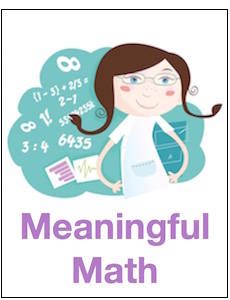Helping Kids Find Their Way in Word Problems
A MiddleWeb Blog

I have to do more than teach my students the math concepts; I have to teach them how to decode what the word problem is actually asking. So the question I’ve been asking myself lately is how do I help my students puzzle through the math questions on the ACT? In other words, how can I help them be effective solvers of word problems?
It’s not that I haven’t been trying. I have tried bell ringers, graphic organizers, teaching key words… and the list goes on. When all these strategies met with limited success, I realized I needed help so I started researching.
I found an article in NCTM’s monthly journal Mathematics Teacher: Learning and Teaching (PK-12) titled “Making Word Problems Meaningful” (August 2021). The article convinced me that a lot of things I’ve tried in the past are not good strategies.
What doesn’t work
For instance, in the past I have given students a set of steps or procedures to follow to solve word problems. The procedural steps usually followed a mnemonic device (e.g., SOLVE) so that it would be easy for the students to remember.
Well, the article plainly states, “forcing students to follow one set of steps to solve word problems has no influence on their ability to solve those problems.”
I have also given students graphic organizers to organize their thoughts about the problem. Many of the graphic organizers had four quadrants where they could draw a picture or put the question in their own words.
This article also discourages doing this, referring to it as “over-scaffolding” and cautioning that it makes “solving word problems tedious and boring.” I can verify that making students do this is tedious for them and for the teacher, but I tried it because I didn’t know what else to do.
Research-backed strategies
So what strategies should we be using in our classroom? This article suggests using some of the same strategies used to improve reading comprehension. The four specific strategies are
(1) visualizing
(2) retelling
(3) making connections and
(4) asking questions.
As mentioned previously, the article recommended against making students write down their questions, connections or retellings in a graphic organizer. Instead these four strategies should be used to help students think about the problem with an emphasis on encouraging students to talk with each other.
Starting small
I am so excited to get started, really dig into this article, and integrate the strategies into my classroom. I also want a chance to do a little more research as well as take a trip to the English department to talk with some of our English teachers.
Besides, I need to get a baseline for where my students are in relation to word problems. Many of the word problems we have done this year have been embedded in the content we are covering at the time. After we learn a math concept, we will then “apply” it by solving a word problem. Not surprisingly, this has not helped students improve in the area of word problems.
So today I gave my students a word problem I found online which had been created for a program called “Closing the Math Achievement Gap.” The problem had no bearing on the concept we are currently learning. I was up front about this with my students.
I let them work in groups of 3 or 4, and I let them choose who they wanted to work with. I gave them the word problem and put 15 minutes on the timer. My only instruction was to read the problem and try to solve it.
It was hard to stay silent
Here is the problem if you are interested:
Your friend leaves for the party 2 hours earlier than you do. (a) If your friend is averaging 50 mph and you are trying to catch him by averaging 60 mph, how many hours will it take for you to catch him? (b) How far will you each have traveled when you catch up to your friend?
I walked around and observed and made notes of what the students said and did. This is what I heard over and over in the first five minutes in all four of my Algebra II classes:
- I hate these problems
- I don’t know where to start
- I was never good at these
- I’m frustrated
I also heard students trying to use the numbers 2, 50, and 60 (the ones mentioned in the problem) without having read the problem. I guess they thought they might just get lucky and come up with the right answer.
I was getting nervous. It was so hard to stay silent. This negative self talk went on for a full five minutes (not among all students – some starting writing and thinking about the problem pretty quickly).
Then I starting hearing words like distance and time – students began to pick up their pencils – and then students started writing things down. Then I heard some “ohh’s.” I could tell some students were making headway.
Even in my most challenging class, by the end of the 15 minutes every group had made some headway. This class had five groups. One group arrived at the correct answer with the correct thinking; two other groups didn’t have the right answer but they had the right thinking. The other two groups had made progress but hadn’t quite worked out the correct thinking.
The rest of my classes more or less followed this same pattern. At the end of the 15 minutes, I took up their work and did not tell them whether their answer was correct or incorrect.
The next day I gave their papers back to them. This time I put 5 minutes on the timer and asked them to get back in their groups and revise their work. I thought they would be bored or uninterested because they had worked on the problem fifteen minutes the day before.

The best thing that happened all day was when a student asked, “But was my thinking right?” As a class, we briefly talked about what the answer was and the different strategies they had used.
Take-aways from this first experiment
Just by observing them working – really observing and listening to them and NOT helping – I learned a lot:
- Most students have not developed the stamina needed to be successful at word problems.
- They need practice working problems that are not connected to a certain topic.
- I have to resist swooping in and telling them what to do.
- They need to be encouraged to talk to each other about what they are thinking.
- They want to do everything “in their head.”
- They need time and practice to begin to see word problems as an important part of mathematical thinking.
I will continue to purposefully work on helping students become more proficient at word problems. I plan to continue this topic in my next post here. The article from NCTM’s Mathematics Teacher: Learning and Teaching titled, “Making Word Problems Meaningful” (summary) will be my jumping off point and blueprint.
In the meantime, if anyone has suggestions or strategies that have helped students become better at working word problems, please share in the comments.
Image by Andreia Joldes from Pixabay
































I enjoyed reading your article and agree that memorized routines are not as useful as a little productive struggle. when moving from basic word problems to math problem solving. Since you asked…I have an open-ended protocol for PS that I’ve used at all grade levels. https://www.karin-hess.com/_files/ugd/5e86bd_93eb20501ec940f9bc23b209f51af098.pdf
In this handout, I differentiate word problems v. problem solving. I like to have small groups discuss the problem together even if they solve individually – what do we really have to find out? how can we use a representation to show the problem? what strategies might work etc. The reasoning behind the solution uses WORDS to describe WHY the strategy worked, etc. Finally, make a mathematical connection beyond the problem (transfer knowledge). Maybe your readers can use this as well.
It is so interesting that you posted this comment today, this morning I was thinking about what constitutes a word problem. Your handout lays out what I was trying to work out in my mind. Thank you so much for this resource, I will definitely be using this in my room.
I’m glad you found it useful. My thinking about word problems is that there is an intended strategy whereas problem solving is more open ended
That makes perfect sense! I’m finding that a lot of things that I think are intuitive are not intuitive for the students, so it’s a learning process for me and them.
See this article here at MiddleWeb by Karin Hess: “Six Ways Teachers Can Support Rigor by Deepening Thinking.”
Agreed! Teachers at all grade levels need to do more “thinking out loud” so kids learn that solutions to more complex problems follow somewhat crooked paths.
I wish there were more Math teachers like you, willing to take the TIME to have students thinks, willing to put them in groups, willing to revisit a problem instead of assigning twenty more problems. Thanks
You are right it takes so much time. At first I felt guilty taking the time but I had tried everything else. Thank you so much!!!!
I used to love word problem and building and solving algebraic equations from them.
Word problems are detective cases. You start with the question of finding out what is the detective story you want to solve not with reading the things that lead up to the questions. How can a detective solve a problem if he does not know what the problem is? He starts with the questions What is involved? Who is involved, when did it happen? How did it happen ? Why? In those questions there are some clues. He asks and follow the clues. In that word problem, there are some clue words that tell you what action needs to be taken. For example the question might be How many were involved in all! The clue word is in all and it tells you to take the action to add. How many were left? The. Lue word is left and it tells you to use the process of subtraction. In summart, use the clues. At the higher levels of problem solving there may be more than one or two clues, there may be information there that is not needed and the level of problem solving can become more difficult just as it in real life detective or legal cases